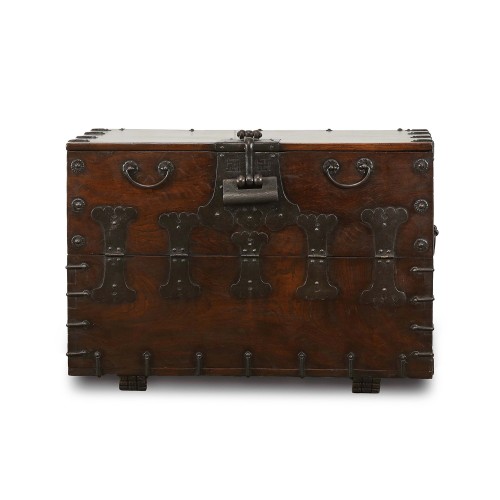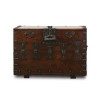본문
장흥 반닫이는 제주와 서남해안 지역의 영향 아래, 과한 장식을 지양하고 단아한 형태를 갖춘 전통 목가구입니다.
앞면에는 버선코형 장석 다섯 개가 일렬 배치되어 시각적 질서를 이룹니다. 문 중앙의 잠금 장석에는 ‘卍(만)’자 문양이 새겨져 있어 길상 의미를 더합니다. 양옆의 활 모양 손잡이와 문판 가장자리에 일정한 간격으로 박힌 광두정(光頭釘)은 기능적 역할을 넘어 시각적인 미감까지 함께 갖춥니다. 또한, 전통 사개물림 짜임으로 뒤틀림을 방지하며 당시 장인의 숙련도가 보입니다.
━━━━━
此长兴半开式箱柜受济州岛及西南海岸地区影响,摒弃繁复装饰,整体造型简洁典雅,体现出当地传统木作家具的质朴之美。
柜面上排列有五枚呈鞋尖形的金属装饰件,营造出视觉上的秩序感。中央锁扣上刻有象征福运的“卍”字纹,寓意吉祥如意。两侧配有弓形提手,门板边缘则均匀钉饰有“光头钉”——不仅具备实用功能,更增添了装饰美感。此外,整件家具采用传统榫卯结构,有效防止木材变形,充分体现了当时工匠精湛的技艺。
━━━━━
This bandaji from Jangheung reflects influences from Jeju Island and the southwestern coastal regions, characterized by a restrained elegance that avoids excessive ornamentation.
Five beoseonko-shaped (button-nose) iron fittings are lined up across the front, establishing visual order. At the center of the panel, the locking plate is engraved with the “卍” (swastika) symbol, which signifies good fortune. On either side, bow-shaped handles and gwangdujeong (decorative nail heads) placed at regular intervals along the panel’s edges contribute both functional and aesthetic value. The traditional sage-mullim (interlocking joint) technique also prevents warping, attesting to the skill of the craftsman at the time.

